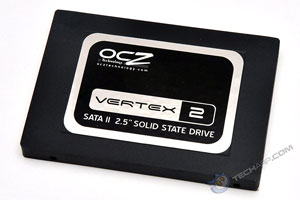Conclusion
 |
OCZ Technology used to offer so many SSD choices that it was a tad confusing for consumers to decide on the ideal SSD for their needs. Fortunately, they finally streamlined their product offerings - their SSD drive families are now much easier to understand. The subject of this review, the extended-capacity Vertex 2 solid state drive, can be seen as the higher-performance version of the OCZ Agility 2 (E) solid state drive we reviewed earlier.
Both the Vertex 2 and the Agility 2 use the same SandForce SF-1222 controller and NAND flash memory, and thus have pretty much the same cell-to-buffer throughput. The main difference between the two drives is the Max IOPS firmware, which allows the Vertex 2 to deliver 5x as many input/output operations per second (IOPS) as the Agility 2. The Vertex 2 is rated at 50,000 4 KB random write aligned transactions per second, while the Agility 2 is only rated at 10,000 transactions per second.
Does this singular advantage translate into significantly better performance? Well, we never came close to the 50,000 transactions per second. The best the Vertex 2 did in the 4 KB random write test was 41,221 IOPS. Even so, that was 3.3x better than the result we recorded for the Agility 2 - 12,535 IOPS. The Max IOPS firmware in the Vertex 2 certainly had a significant effect on its performance with multiple simultaneous operations, just not as much as we expected.
Interestingly, our IO Meter results also showed that the Max IOPS firmware appears to boost the Vertex 2's large 512 KB write performance, for both random and sequential writes. But how does all that translate to real world performance?
Well, the OCZ Vertex 2 proved to be slightly faster than the OCZ Agility 2. In the Business Disk test, the Vertex 2 was faster by 6.4%, but that performance gap increased to 7.8% in the High-End test. Of course, this test is only an indication of office application performance. In such a usage pattern, the OCZ Vertex 2 is slightly faster than the OCZ Agility 2. The Vertex 2's Max IOPS firmware can only show its full potential when used in a highly-threaded, multitasking environment, e.g. in a server.
Do keep in mind that we are comparing the Vertex 2 to the Agility 2 which is a very fast SSD, as we pointed out in our review. Both the OCZ Vertex 2 and the OCZ Agility 2 are so fast that they leave the competition in the dust. It would be hard for the Vertex 2 to improve on every aspect of the Agility 2's performance without resorting to the use of a faster controller or faster flash memory.
If there is a "potential" issue we have to point out, it is the extended-capacity Vertex 2 models' use of spare memory cells to boost the drive's storage capacity by 20% - from 100 GB to 120 GB in this model's case. This leaves the Vertex 2 (E) with a flash memory reserve of just 7%. This reserve is important not only as a reservoir of spare memory cells to replace cells that degrade over the drive's lifespan, it also allows the SandForce SF-1222 controller to better perform garbage collection.
Of course, most solid state drives have a similar reserve of just 7%, and MLC flash memory is generally rated for at least 10,000 writes and should last at least 2-3 years. So one could argue that most of the SSD's spare memory cells are being wasted sitting on the bench, used only for garbage collection or just waiting to replace active memory cells that would only start to die after 2-3 years of use.
Extended capacity models of the OCZ Vertex 2 solid state drives are sold at around the same price as their standard capacity brethren. This is only fair as both models are physically the same, and therefore are equal in cost as well. However, the extended capacity models will have the advantage of not only a higher storage capacity, but also a much lower cost per GB, making them much more attractive to those who are looking for more bang for their buck.
Overall, we are most impressed with the performance of the OCZ Vertex 2 (E) 120 GB solid state drive. It combines a good amount of storage capacity, ground-breaking read and write performance in an affordable (click here for the lowest prices) package that is backed by an excellent 3 year warranty. In fact, we think so highly of it that we feel it deserves no less than our Reviewer's Choice Award! Congratulations, OCZ!

To find the lowest price for OCZ Vertex 2 solid state drives, click here!
Support Tech ARP!
If you like our work, you can help support out work by visiting our sponsors, participate in the Tech ARP Forums, or even donate to our fund. Any help you can render is greatly appreciated!
Page |
Topic |
|
1 |
||
2 |
||
3 |
• The Vertex 2 (E) 120 GB SSD |
|
4 |
||
5 |
||
6 |
||
7 |
||
8 |
||
9 |
||
10 |
||
11 |
||
12 |
Questions & Comments
Please feel free to post your questions or comments here!
| Date | Revision | Revision History |
02-10-2010 |
1.0 |
Comprehensive review release. |
26-10-2010 |
2.0 |
Added new IOPS scaling results for random and sequential accesses. |
22-04-2011 |
3.0 |
Major revamp of the review, with numerous updates and corrections. |







 Add to Reddit
Add to Reddit
